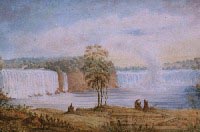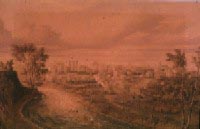
 |
View of the Horseshoe and American Falls from the Canadian Side (c. 1850), watercolour on paper, 18 x 25 cm., purchased with funds from the Somerville Bequest, 1984 |
 |
View of London, Canada West (c. 1845), watercolour, gouache and graphite on paper, 34 x 51.7 cm., gift of the Estate of Albert Templar, 1992 |
John Herbert Caddy (1801-1883) was the son of a British colonel in Royal Artillery at Quebec City. He spent his youth at Amherstburg in Upper Canada. His early art and military studies were at Royal Military Academy, Woolwich, England from 1815 to 1816 and like his father, entered the Royal Artillery as a cadet. He was commissioned as second lieutenant 1825, lieutenant 1827, and captain 1840. Caddy served intermittently in West Indies from 1828 to 1841 then in Canada from July 1842 to 1844 when he retired on half pay and chose to remain in Canada on retirement. Caddy was first town engineer in London, Canada West from 1841 to 1851 and later was an engineer for Great Western Railway in Hamilton until 1856. He had always been interested in painting as an amateur and, on retirement from work as an engineer, devoted his full time to painting. Early in his career, he had done some private teaching of art later working in this profession at Wesleyan Female College, Hamilton where he also maintained a studio from 1856.
An artistic highlight of his career was his association with Patrick Walker and their archaeological excavations at Palenque, British Honduras from 1838 to 1841. Caddy drew many of their Mayan findings which are now at the Royal Ontario Museum. In Canada, he exhibited until 1858 as amateur and thereafter as professional and was awarded prizes for watercolour paintings of Canadian landscapes, marines, flower studies, animals and sepia drawings.
|
 |
|